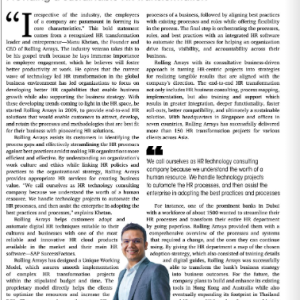The Five Myths of Compensation Management — Exposed
The Five Myths of Compensation Management — Exposed
[authorblog]
[postsociallinks]

Even within the well-run companies, pockets of resistance or misunderstanding can pop up among managers who are ultimately accountable for bringing pay strategies to life. You may have heard some of these myths:
1. “All of my people are good performers or they wouldn’t be here.” While this statement may be true, numerous industry reports confirm that companies improve performance — in terms of both revenue and profitability — when their compensation and rewards programs are clearly differentiated based on individual performance.
2. “The company met its year-end targets, so everyone should share the same rewards.” There are times when spreading compensation rewards evenly across the organization is perfectly appropriate — for example, the sharing of team or profit-based bonuses. However, this type of “peanut butter” approach doesn’t work for rewarding your top performers. Actually, it can create retention problems for these high-value employees.
3. “I can’t afford to discourage or disengage anyone on my team with no pay increase. I’m short-staffed as it is.” Diverting well-earned rewards from top performers is the disengagement risk you should worry about most. Holding a frank conversation with an underperforming employee who’s receiving a minimal pay increase may be challenging. However, these conversations are an essential part of a compensation strategy that rewards results.
4. “I know some people talk about confidential pay issues, and I don’t want the word to spread.” When employees clearly understand how their performance will be evaluated and rewarded in a transparent way, they’re less likely to have misgivings about a compensation program.
5. “I don’t have enough insight to differentiate performance.” Managers need factual and relevant feedback, observations, insight, and data to make fair decisions about pay. Getting quality information like this can be difficult and time-consuming, especially when working with paper or spreadsheets. An automated compensation solution makes it easier for managers to make sound pay decisions based on a complete picture of employees’ performance.
Attracting, motivating, and maintaining a productive workforce requires more than equitable salaries and wages. Don’t let these myths prevent you from moving toward performance-based rewards. Effective compensation management, as part of an integrated performance management process, can engage employees, ignite better performance, improve execution, and ensure retention of the true top talent. You can dispel these myths easily with a few simple steps: a focus on total rewards, the alignment of goals, appropriate calibration and differentiation, the right technology, and good employee communication.
Source: SuccessFactors “ Pay, Performance, and Productivity”white paper
Rolling Arrays is Asia’s premier award winning HR transformation company, headquartered in Singapore with offices in 6 countries. Since its inception in transformation projects for more than 50 blue-chip clients across Asia. A consultative approach to HR processes, HR functions and HR software is Rolling Arrays core expertise and the primary catalyst for its success.
[likeblogpostbutton] [sharethisbuttons]







